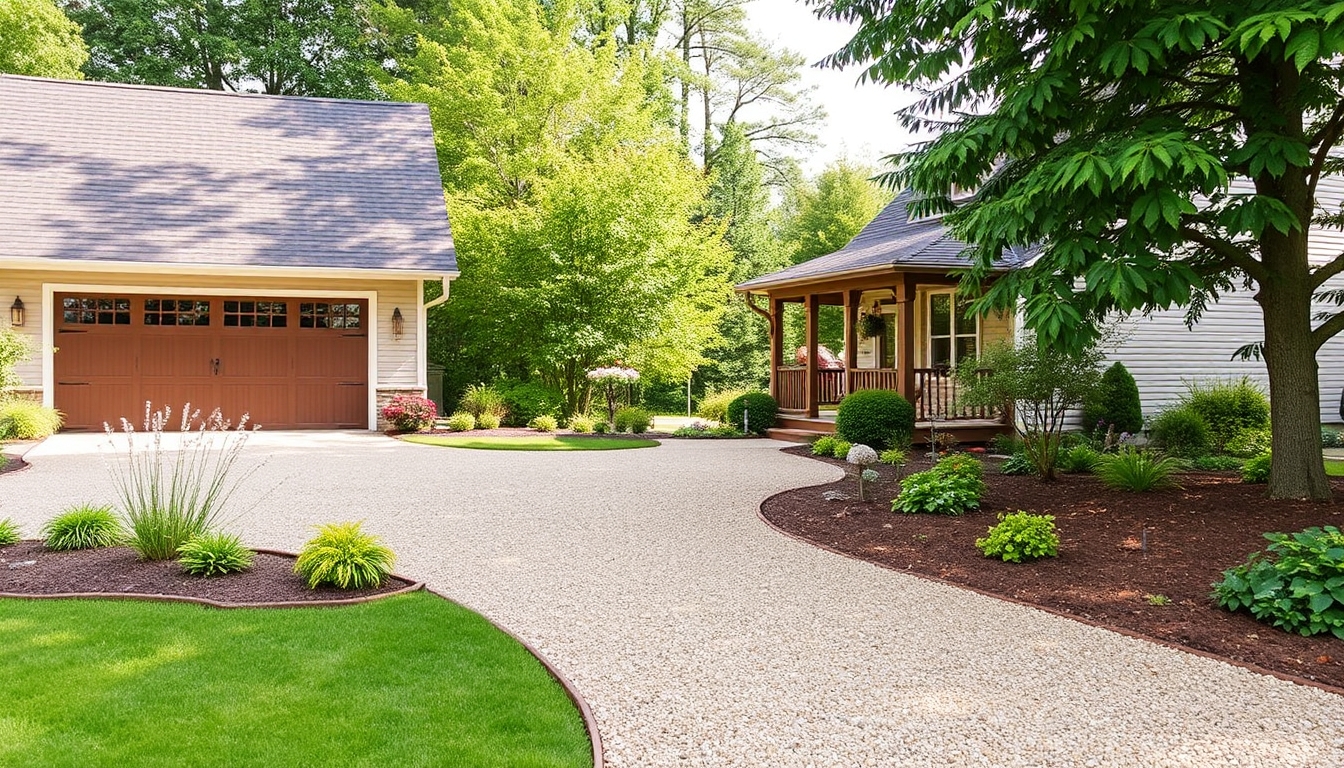Are you tired of the potholes and mud that plague your driveway? Perhaps it’s time to consider building a gravel driveway. Not only can it enhance the curb appeal of your property, but it’s also a cost-effective and relatively simple DIY project. In this informative guide, we’ll walk you through the step-by-step process of creating a beautiful and durable gravel driveway that will stand the test of time. So, grab your tools and let’s get started!
Choosing the Right Location
Before you start digging, it’s crucial to select the perfect location for your gravel driveway. Consider the following factors:
1. Accessibility
Ensure that your driveway is conveniently accessible from the main road and can accommodate the vehicles you own. Take into account any potential obstructions such as trees, utility lines, or drainage ditches.
2. Drainage
Proper drainage is essential to prevent water pooling on your driveway. Look for an area with natural slope or consider grading the land to ensure water runoff flows away from your driveway.
3. Soil Stability
Assess the stability of the soil in your chosen location. Avoid areas with soft or sandy soil that may shift over time. Ideally, you want a solid foundation to support the weight of vehicles.
4. Utility Lines
Check for any underground utility lines like gas, water, or electricity before digging. Contact your local utility companies to mark the lines and prevent any accidents during construction.
Once you’ve carefully considered these factors and pinpointed the perfect spot, you’re ready to move on to the next step in building your gravel driveway.
Gathering the Necessary Tools and Materials
Before you begin constructing your gravel driveway, it’s important to gather all the essential tools and materials. Here’s a comprehensive list:
1. Measuring Tools
Have a tape measure, stakes, and string on hand to mark the boundaries of your driveway and ensure accurate measurements.
2. Shovels and Rakes
You’ll need shovels and rakes for excavation, leveling the ground, and spreading the gravel evenly.
3. Compactor
A compactor or a tamper is necessary to compact the soil and create a solid base for your driveway.
4. Geotextile Fabric
Using geotextile fabric is highly recommended as it helps prevent weed growth, stabilizes the soil, and improves drainage.
5. Gravel
Choose the type and size of gravel that suits your preferences and budget. Consider factors like durability, appearance, and availability in your area.
6. Edging Material
Edging material like bricks or pavers can help define the boundaries of your driveway and keep the gravel in place.
By ensuring you have all the necessary tools and materials, you’ll be well-prepared to tackle the next steps in constructing your gravel driveway.
Preparing the Ground
Properly preparing the ground is crucial to ensure the longevity and stability of your gravel driveway. Follow these steps:
1. Excavation
Using your shovels, begin excavating the area where your driveway will be located. Remove any vegetation, rocks, or debris. Aim for a depth of about 6 to 8 inches.
2. Grading
With the help of rakes, smooth out the surface and create a slight slope to allow for proper drainage. Ensure the slope is away from any structures or nearby roads.
3. Compacting
Use a compactor or tamper to compact the soil evenly and create a solid base. Pay extra attention to areas with softer or looser soil, as they may require additional compaction.
4. Installing Geotextile Fabric
Unroll the geotextile fabric over the excavated area, making sure it covers the entire surface. Trim any excess fabric and secure it with stakes or pins to keep it in place.
5. Adding a Layer of Gravel
Pour a layer of gravel onto the fabric, starting with larger-sized gravel as the base layer. Use rakes to spread it evenly and achieve a uniform thickness of around 4 inches.
By thoroughly preparing the ground, you’ll create a solid foundation for your gravel driveway, minimizing the risk of future issues and ensuring its longevity.
Installing and Maintaining Your Gravel Driveway
Now that the groundwork is complete, it’s time to install and maintain your gravel driveway. Follow these steps:
1. Spreading Gravel
Add another layer of gravel on top of the base layer, this time using smaller-sized gravel. Spread it evenly with rakes until the desired thickness is achieved.
2. Compact the Gravel
Use a compactor or tamper to compact the gravel, ensuring a solid and stable surface. Repeat this step a few times to achieve optimal compaction.
3. Install Edging
Place the chosen edging material along the boundaries of your driveway, securing it firmly into the ground. This will help contain the gravel and give your driveway a clean, finished look.
4. Regular Maintenance
Regularly inspect your gravel driveway for any signs of erosion, ruts, or weed growth. Fill in any depressions or ruts with additional gravel and use a weed killer to prevent weed growth.
5. Periodic Replenishment
Over time, your gravel driveway may experience wear and require replenishment. Add a fresh layer of gravel as needed to maintain a smooth and even surface.
By following these installation and maintenance steps, you can ensure that your gravel driveway remains functional, visually appealing, and durable for years to come.
Considerations and Benefits of a Gravel Driveway
Before finalizing your decision to build a gravel driveway, it’s important to consider some key factors and understand the benefits it offers:
1. Cost-Effectiveness
Compared to other driveway materials like concrete or asphalt, gravel is a more affordable option, making it a budget-friendly choice for homeowners.
2. Versatility
Gravel driveways come in various colors, sizes, and textures, allowing you to choose the style that best suits your property and personal preferences.
3. Easy Installation
Constructing a gravel driveway is a project that can be done by homeowners with basic DIY skills. You have the satisfaction of completing the project on your own.
4. Excellent Drainage
Gravel driveways offer superior drainage, preventing water accumulation and reducing the risk of ice formation during colder months.
5. Low Maintenance
With periodic maintenance such as filling in ruts and applying weed killer, gravel driveways require minimal upkeep compared to other materials.
6. Eco-Friendly Option
Gravel is a natural material that doesn’t require extensive mining or manufacturing processes, making it an environmentally friendly choice.
By considering these factors and understanding the benefits, you can confidently proceed with your decision to build a gravel driveway.
Conclusion: Enjoy Your Newly Constructed Gravel Driveway
Congratulations on completing the construction of your gravel driveway! With proper planning, preparation, and maintenance, you’ve created a beautiful and durable entrance to your property. Here’s a quick recap:
1. Location
Choose a suitable location for your driveway that is easily accessible, has proper drainage, stable soil, and minimal utility line interference.
2. Tools and Materials
Gather all the necessary tools and materials, including measuring tools, shovels, rakes, a compactor, geotextile fabric, gravel, and edging material.
3. Ground Preparation
Thoroughly excavate the area, grade the ground, compact the soil, and install geotextile fabric for stability and improved drainage.
4. Installation and Maintenance
Spread and compact multiple layers of gravel, install edging material, and perform regular maintenance to ensure a long-lasting and visually appealing driveway.
5. Considerations and Benefits
Take into account the cost-effectiveness, versatility, easy installation, excellent drainage, low maintenance, and eco-friendliness of gravel driveways.
Now, it’s time to enjoy the benefits of your newly constructed gravel driveway. Embrace the enhanced curb appeal, improved functionality, and the satisfaction of completing a DIY project that will serve you well for years to come.
Additional Tips and Considerations
As you wrap up your gravel driveway project, here are a few additional tips and considerations to keep in mind:
1. Maintenance Schedule
Establish a regular maintenance schedule for your gravel driveway. This may include periodic inspections, weed control, and replenishing gravel as needed.
2. Snow Removal
If you live in an area with heavy snowfall, consider the snow removal process for your gravel driveway. Use a snowplow with adjustable blades or a snowblower to avoid damaging the surface.
3. Vehicle Weight Distribution
Be mindful of how vehicles are parked and distributed on your gravel driveway. Avoid concentrated weight in one area, as it may cause ruts or displacement of the gravel.
4. Edging Maintenance
Regularly inspect the edging material to ensure it remains intact and secure. Replace any damaged or loose sections to maintain the integrity of your driveway’s boundaries.
5. Consider Professional Help
If you’re unsure about any aspect of the construction or maintenance process, don’t hesitate to seek professional help. They can provide guidance and ensure the best results.
By following these additional tips and considerations, you’ll be able to maintain the longevity and aesthetics of your gravel driveway, adding value to your property for years to come.
Final Thoughts: The Beauty and Practicality of a Gravel Driveway
As you conclude your journey in building a gravel driveway, reflect on the beauty and practicality it brings to your home. Here are some final thoughts to consider:
1. Aesthetics
Gravel driveways offer a charming rustic appeal that can complement various architectural styles. The natural colors and textures of the gravel add character to your property.
2. Environmental Impact
Choosing a gravel driveway demonstrates your commitment to sustainability. Unlike concrete or asphalt, gravel allows rainwater to penetrate the soil, reducing runoff and benefiting the local ecosystem.
3. Flexibility
Gravel driveways are versatile and can be easily modified or expanded. If you decide to change the layout or add additional parking spaces, it can be accomplished without extensive reconstruction.
4. Neighborhood Harmony
Gravel driveways blend well with the surrounding environment, maintaining neighborhood harmony. They can seamlessly integrate into both urban and rural settings.
5. Personal Touch
Your gravel driveway is unique to your property. You have the freedom to choose the gravel type, color, and size that aligns with your personal style and preferences.
Embrace the beauty and practicality of your newly constructed gravel driveway. Enjoy the convenience, cost-effectiveness, and timeless appeal it brings to your home. With proper care and maintenance, it will serve you and your property for years to come.
In conclusion, building a gravel driveway is a rewarding and practical DIY project that can enhance the functionality and aesthetics of your property. By carefully selecting the location, gathering the necessary tools and materials, preparing the ground meticulously, and following proper installation and maintenance techniques, you can create a durable and visually appealing driveway. Gravel driveways offer cost-effectiveness, versatility, and excellent drainage, making them a popular choice for homeowners. Additionally, they are environmentally friendly and can be customized to reflect your personal style. Embrace the beauty and practicality of your newly constructed gravel driveway and enjoy the benefits it brings to your home. With regular maintenance and care, your gravel driveway will serve you well for years to come.






